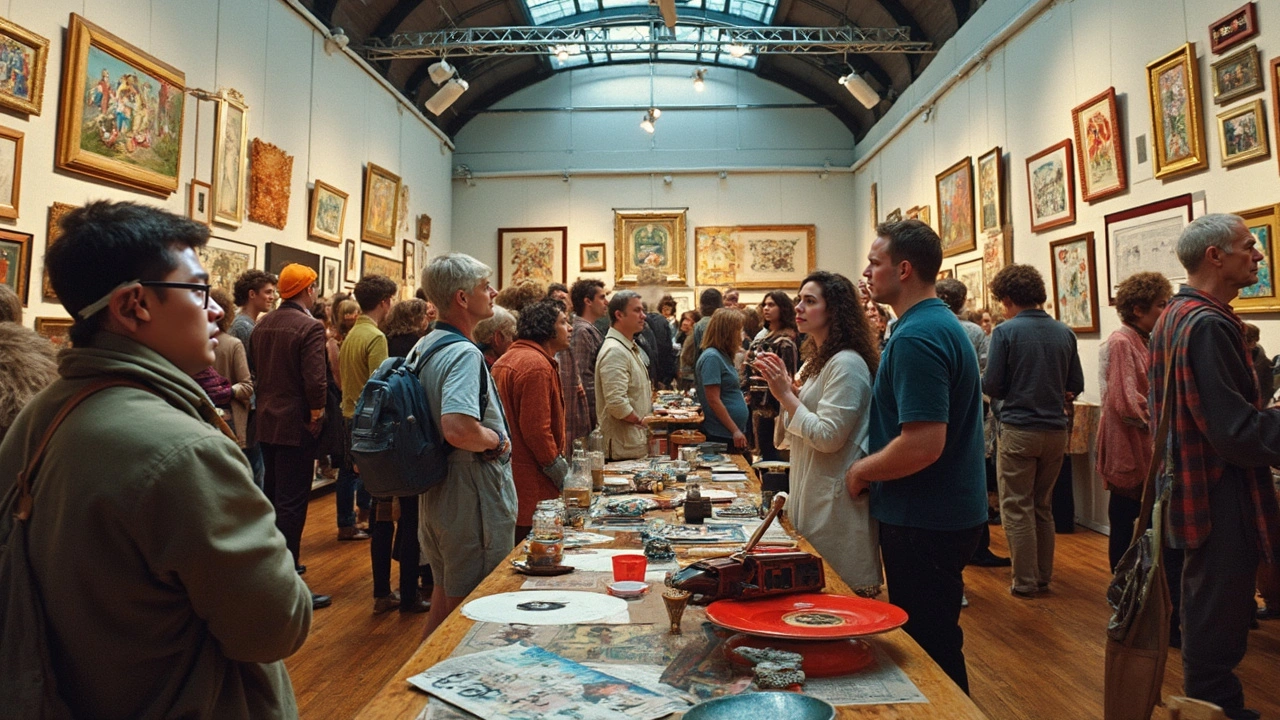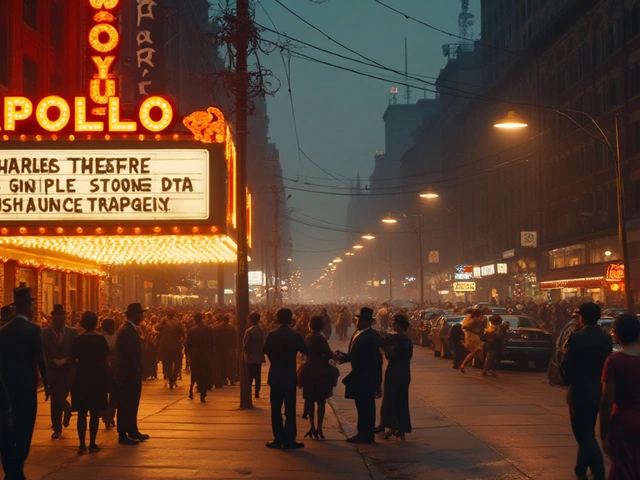Stuffing a piano full of nails and calling it art? That’s straight out of the Fluxus playbook. If that sounds bizarre, you’re already catching the vibe. Fluxus artists were all about ripping up the rule book and showing that art isn’t locked in a fancy museum—it could be a joke, a happening, or even a pile of random objects in your kitchen. Their wild, sometimes head-scratching pieces got people talking—and, honestly, a little mad.
What’s cool about Fluxus is how it blurred the line between creator and crowd. No need for a brush or canvas. Surprise performances popped up at parks, train stations, or wherever people least expected it. These artists turned the stuff everyone ignored—like playing cards, clocks, and even silence—into art that made folks stop and question what “art” really means.
Feeling stuck in a creative rut? Fluxus teaches us to play, mess up, and not take things too seriously. Grab a random object, squeeze in some humor, and see where it leads. That’s the real legacy of this movement: breaking rules for the sheer fun of it, without worrying if it’s fancy or deep.
- What Made Fluxus Tick?
- The Big Names and Their Wild Ideas
- Fluxus Tricks That Changed the Game
- Why Fluxus Still Matters Today
What Made Fluxus Tick?
If you want to get to the bottom of what set Fluxus apart, you have to start with its attitude. Fluxus popped up in the 1960s—a time when the art world took itself pretty seriously. Marcel Duchamp’s urinal had already rocked the boat, but Fluxus threw the whole thing overboard. They ditched old-school art forms and made performances, instructions, and everyday objects the stars of the show.
There wasn’t one single founder, but George Maciunas is the name to know if you’re digging into the history. He built the first Fluxus festivals around 1962, inviting artists to stage unpredictable events instead of showing finished paintings or sculptures. Fluxus artists wanted to cut out the middleman: no need for critics, galleries, or even a proper stage.
The word “Fluxus” means flow or change—and that’s no accident. The group hated anything fixed or stuffy. Their motto was almost “anything goes,” but with a wink. Fluxus events could be as simple as pouring water from one glass to another. The point was to poke fun at tradition and remind people that life’s little moments matter just as much as any masterpiece.
What really made Fluxus different from other avant-garde groups is how they mixed different art forms—music, poetry, visual art, and even jokes—so that boundaries basically disappeared. They distributed cheap, handmade booklets called "Fluxkits" that anyone could copy at home. This way, Fluxus challenged the whole idea that art had to be precious or expensive.
- Fluxus started in the early 1960s, mainly in New York but also in Europe and Japan.
- George Maciunas, Yoko Ono, and Nam June Paik were key players from day one.
- Its events felt DIY—think pop-up performances, mail art, and audience participation.
- They questioned what counted as art, focusing on fun, freedom, and breaking habits.
The Big Names and Their Wild Ideas
Fluxus roped in a crew of artists who weren’t afraid of ruffling feathers—or of a little chaos on the gallery floor. These people didn’t just hang paintings. They turned jokes, everyday junk, even silence into art that made people stop and think. Here’s a look at the folks who really lit the fire:
- George Maciunas: The brains behind the whole Fluxus thing. Maciunas loved poking fun at stuffy art traditions. He organized the first major Fluxus events in the early 1960s and even designed wild, puzzle-like art kits. Without him, Fluxus would never have taken off the way it did.
- Yoko Ono: Sure, she’s known for The Beatles connection, but way before that, Yoko was making people do weird stuff in galleries—like climbing ladders to read tiny messages or watching a fly crawl over a naked body in her film "Fly." She proved art could be an experiment, not just something to hang on the wall.
- Nam June Paik: The guy who basically invented video art. He put magnets on TV screens, played cello with TV sets, and even had Charlotte Moorman play music while in a bathtub. Paik’s wild stunts turned technology into art supplies.
- Alison Knowles: She cooked up interactive performance pieces like “Make a Salad,” where she chopped salads for crowds as art. She also made “event scores”—simple scripts for anyone to carry out an artwork in real life.
- Ben Vautier: Famous for signing pretty much anything—as in literally signing his own body or a window and calling it art. His work dared people to consider, “If this is art, what isn’t?”
These artists cared less about money and more about fun, freedom, and the element of surprise. Their approach let people question everything they thought they knew about art. Here’s a quick look at their main contributions:
| Artist | Famous Works/Actions | Impact |
|---|---|---|
| George Maciunas | Fluxus Manifesto, art kits | Organized Fluxus and set its anti-art tone |
| Yoko Ono | Cut Piece, Grapefruit, Fly | Brought interactive and conceptual art into the spotlight |
| Nam June Paik | TV Cello, Magnet TV | Pushed art into the world of tech and video |
| Alison Knowles | Make a Salad, event scores | Made art for everyone, not just artists |
| Ben Vautier | Signing works, performance actions | Quirky approaches to authorship and definitions of art |
If you’re ever at a museum and see a piece that makes you ask, “Is that really art?”—there’s a good chance one of these Fluxus icons had something to do with that impulse.

Fluxus Tricks That Changed the Game
Fluxus artists didn't just make art—they messed with every idea about what art was supposed to be. They hacked the system with some wild and simple tricks. Yoko Ono's "Cut Piece" might be the best-known example: she sat still onstage and let the audience snip off bits of her clothing, turning a passive experience into something raw and very real. Talk about nerve.
George Maciunas, a founder of Fluxus, made "Fluxkits." These looked a lot like kid’s science kits, packed with weird objects—tiny games, tools, or even instructions. The whole point was to let anyone mess around and call it art. If you ever see little boxes with oddball stuff inside at an art show, you’re seeing the legacy of these kits.
Sound was fair game, too. Remember Nam June Paik? He rigged up pianos with tacks and sometimes crawled under them to make noises during concerts. He even handed out random household items to the crowd and called it a performance. The goal was to ask, “Anybody can do this, right?” That energy still pops up in contemporary art today.
Mail art was a big Fluxus hit. Instead of creating a masterpiece to hang on a wall, artists sent postcards, doodles, or even instructions to random people. The art didn’t just travel; it changed along the way. Below is a quick look at some signature Fluxus tricks, where and when they shook things up:
| Trick | Artist | Year | Where |
|---|---|---|---|
| Cut Piece | Yoko Ono | 1964 | Kyoto, Japan |
| Fluxkits | George Maciunas | 1962-1978 | USA/Europe |
| Random Piano Performances | Nam June Paik | 1960s | New York, USA |
| Mail Art | Ray Johnson | 1960s | International |
Want to channel your inner Fluxus? Try this: write instructions for something silly (like, “Clap twice, then hop in place, then give someone a high five”), hand it out to friends, and see what happens. That’s pretty much what these artists did—no special skills required, just the guts to break the rules.
Why Fluxus Still Matters Today
Most folks think of big paintings when they hear “art,” but because of Fluxus, that’s not the only picture in our heads anymore. This movement opened the door for performance art, DIY shows, and even memes. When you see a banana duct-taped to a wall or an artist doing a random stunt on TikTok, you’re staring at a little piece of Fluxus DNA.
In museums, Fluxus still pulls crowds. According to the Museum of Modern Art, their 2022 Fluxus exhibit got over 300,000 visitors—proof that the spirit of breaking the rules still draws curious minds. Even school programs use Fluxus-style exercises to get kids thinking outside the box, like creating sound pieces from household junk or writing instructions as art.
Here’s where Fluxus shines in today’s world:
- Interactive art: You’re not just supposed to look at art anymore. A lot of installations want you to touch, move, or even be part of it—thanks to the trail Fluxus blazed.
- Collab over ego: Fluxus hated the idea of the ‘genius artist.’ Now, group projects are way more common, especially online.
- Value in the ordinary: Found-object art lives on, whether that’s a sculpture made from skateboard decks or music made with trash bins.
Look at this quick comparison to track the Fluxus effect:
| Before Fluxus | After Fluxus |
|---|---|
| Painters and sculptors ruled | Performance and happenings popped up |
| Art in fancy galleries | Art anywhere—even streets or bathrooms |
| Objects only | Ideas and actions count as art |
So, why should you care now? Because the line between art and life is thinner than ever. Every TikTok challenge, flash mob, or kitchen jam session owes something to those Fluxus rebels. If you’re making something weird and new, you’re part of that story too.




